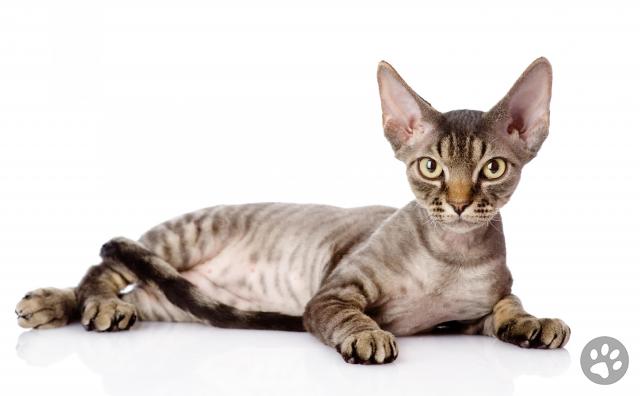Average Size: Medium
Average Weight: 2 to 4 kgs
Average Height: 27 to 38 cms
Life Expectancy: 9 to 15 Years
Activity Level: Average
The Devon Rex is a very lively and curious breed. They’re interested in everything that is going on around them and refuse to be left out of any activity. They welcome attention from all people and are very quick to communicate their opinion in a quiet and gentle voice. They are a very mischievous and agile breed but they also like to snuggle and eat. They will snack themselves into a few extra pounds if you don't carefully monitor their food intake.
Devon Rex’s are generally healthy but they have been known to have a disease called Congenital hypotrichosis, otherwise known as hereditary baldness. This is a condition that is usually the result of an inherited recessive gene. Naturally, the Devon Rex has a very fine coat, but those with less hair than normal for the breed are considered to be hypotrichosis. They also may suffer from Malassezia Dermatitis. This is a single-celled yeast that causes ear infections, itchiness and greasy skin, which can be treated with antifungal drugs. They can also fall victim to Devon Rex myopathy, (also known as spasticity). This is an inherited condition that becomes evident between 3 weeks and 6 months of age. It causes generalized muscle weakness, and the cats tire easily. No treatment is currently available, and severity of the condition varies. It may remain stable or progress slowly. This quite rare and a simple DNA test can reduce the prevalence of this inherited disorder.
The Devons wavy coat is low maintenance. You should groom gently so that you don't break the delicate hairs. A simple brush over their coat with a hand is all they need. Baths are not necessary unless the cat is white or has a lot of white colouring on their coat. Teeth brushing is always necessary to prevent Periodontal disease. Daily dental hygiene is best but weekly maintenance is better than nothing. You should wipe around the corners of their eyes with a soft cloth to get rid of any discharge. Using a different cloth for each eye is recommended so that you don’t run the risk of spreading any infection. The Devon Rex has very prominent and spectacular cheekbones and ears that are accompanied by a set of sparkling eyes. Their body is well covered with fur, most thickly on the back, sides, tail, legs, face and ears. They come in most genetically possible colours or patterns including solid white, blue, black, chocolate, cinnamon, red and lavender; smoke patterns, which are a white undercoat deeply tipped with a specific colour; and various calico, tabby, pointed and tortoiseshell patterns.

